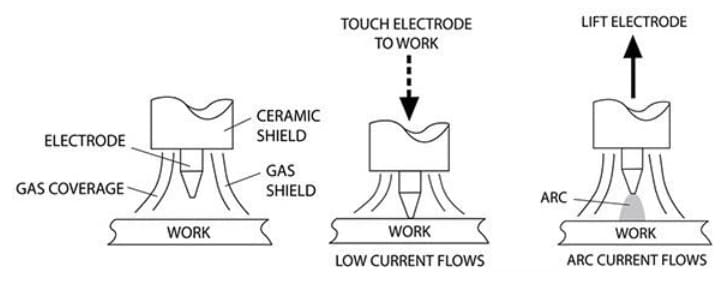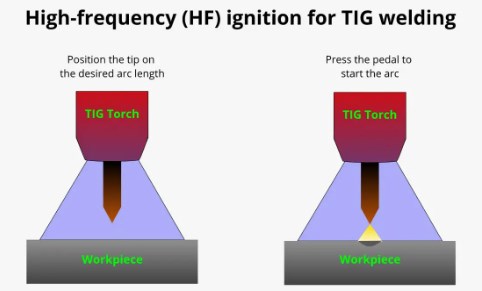TIG welding is a high-quality welding process that requires precise control and skill. TIG stands for tungsten inert gas, which refers to the use of a non-consumable tungsten electrode and an inert shielding gas to create the arc and protect the weld pool. TIG welding can produce clean, strong, and aesthetically pleasing welds on a variety of metals, such as steel, aluminum, copper, and titanium. (To know MIG VS TIG Welding: What are the Differences?)
However, TIG welding also has some challenges, such as how to start the arc without damaging the electrode or contaminating the weld. There are three main methods of arc ignition in TIG welding: scratch-start, lift-arc, and HF (high frequency) ignition. Each method has its own advantages and disadvantages, depending on the application, the equipment, and the operator’s preference. In this blog post, we will explain what each method is, how it works and what are the pros and cons of using it.

I. Scratch-Start TIG Ignition
Scratch-start is the simplest and most basic method of arc ignition in TIG welding. It is usually found on low-cost inverter welders that have been designed primarily for stick (MMA) welding. To start the arc, the operator scratches the tungsten electrode on the workpiece, similar to striking a match. The electrode must be quickly lifted off the workpiece to prevent it from sticking, but not too far to avoid extinguishing the arc.
Scratch-start is not a very user-friendly or reliable method, as it can easily damage the electrode tip or cause tungsten inclusions in the weld. Tungsten inclusions are small pieces of the electrode that break off and remain in the weld metal, acting as defects that can compromise the weld quality and strength. Scratch-start also requires a lot of practice and skill to perform consistently, especially on thin or delicate materials.
1) The advantages of scratch-start are:
It almost always works, as it is based on the principle of a short circuit.
It is affordable, as it does not require any special equipment or features on the welding machine.
2) The disadvantages of scratch-start are:
It can damage the electrode tip, requiring frequent re-sharpening or replacement.
It can cause tungsten inclusions in the weld, requiring rework or rejection.
It can be difficult to control, especially on thin or delicate materials.
It can be unsafe, as it can create sparks or slag that can fly off and injure the operator or damage the surroundings.
II. Lift-Arc TIG Ignition
Lift-arc is a more advanced and refined method of arc ignition in TIG welding. To start the arc, the operator touches the tungsten electrode on the workpiece and lifts it off. The welding machine senses the contact and the break and adjusts the current accordingly. The start-up current is very low, so the electrode barely sticks to the workpiece and the tip is not damaged. The welding current is then gradually increased to the set value, creating a smooth and stable arc.
Lift-arc is a very user-friendly and controllable method, as it does not require any special skills or techniques to perform. It also minimizes the risk of electrode damage or tungsten inclusions, resulting in a cleaner and more consistent weld. However, lift-arc also depends on the quality and calibration of the welding machine, as the electronic processes must be carefully tuned to achieve optimal results. If the start-up current is not minimized, it can still cause the electrode to stick excessively or burn off.
1) The advantages of lift-arc are:
It is easy to use and control, as it only requires touching and lifting the electrode.
It minimizes electrode damage and tungsten inclusions, resulting in a cleaner and more consistent weld.
It is safe, as it does not create any sparks or slag.
2) The disadvantages of lift-arc are:
It depends on the quality and calibration of the welding machine, as the electronic processes must be carefully tuned to achieve optimal results.
It can still cause the electrode to stick or burn off if the start-up current is not minimized.
III. HF TIG Ignition
HF (high frequency) ignition is the most sophisticated and convenient method of arc ignition in TIG welding. To start the arc, the operator simply positions the tungsten electrode near the workpiece and presses the torch trigger. The welding machine generates a high-frequency spark that jumps from the electrode to the workpiece, creating the arc. The electrode does not touch the workpiece at all, so there is no risk of electrode damage or tungsten inclusions.

HF ignition is the preferred method for most TIG welders, as it offers the highest level of quality and convenience. It also allows the operator to start the arc at a distance, which can be useful for welding in tight or awkward spaces. However, HF ignition also has some drawbacks, such as the cost and complexity of the equipment, interference with other electronic devices, and the potential health hazards of high-frequency radiation.
1) The advantages of HF ignition are:
It offers the highest level of quality and convenience, as it does not require any contact or movement of the electrode.
It eliminates electrode damage and tungsten inclusions, resulting in the cleanest and most reliable weld.
It allows the operator to start the arc at a distance, which can be useful for welding in tight or awkward spaces.
2) The disadvantages of HF ignition are:
It is expensive and complex, as it requires a special feature and circuit on the welding machine.
It can interfere with other electronic devices, such as radios, phones, or computers, causing noise or malfunction.
It can pose health hazards, such as electric shocks, burns, or eye damage, due to the high-frequency radiation.
Learn High-Frequency TIG Welding and its Wide-range Applications.
IV. Conclusion
TIG welding is a high-quality welding process that requires precise control and skill. There are three main methods of arc ignition in TIG welding: scratch-start, lift-arc, and HF ignition. Each method has its own advantages and disadvantages, depending on the application, the equipment, and the operator’s preference. Scratch-start is the simplest and most basic method, but it can damage the electrode or contaminate the weld. Lift-arc is a more advanced and refined method, but it depends on the quality and calibration of the welding machine. HF ignition is the most sophisticated and convenient method, but it is expensive and complex and can interfere with other electronic devices or pose health hazards. The operator should choose the method that best suits their needs and expectations and always follow the safety precautions and best practices for TIG welding.
You may also want to know Solutions to 10 Common TIG Welding Problems.





